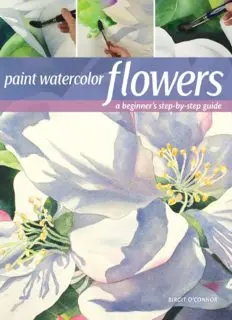
Paint Watercolor Flowers: A Beginner’s Step-By-Step Guide PDF
Preview Paint Watercolor Flowers: A Beginner’s Step-By-Step Guide
Paint Watercolor Flowers Birgit O’Connor CINCINNATI, OHIO ArtistsNetwork.com Watercolor Materials You Will Need These are the materials needed to complete the exercises and demonstrations in this book. I noted the brand I used in parentheses, but use any brand you prefer. For advice on choosing materials, see Chapter 1. Paper Cold press (Arches), 140-lb. (300gsm) for practice and 300- lb. (640gsm) for finished paintings Brushes No. 30 natural round Nos. 8, 14 and 20 sable/synthetic blend round No. 3 synthetic round 2" (5cm) bamboo hake Mop or other wash brush (such as Mottler no. 60 synthetic wash brush) Transparent Watercolors (all by Winsor & Newton except where noted) Burnt Sienna • Cerulean Blue • Cobalt Blue • French Ultramarine Blue • Green Gold • Hansa Yellow Medium* • Indanthrene Blue • Indian Yellow • Indigo • Permanent Alizarin Crimson • Permanent Rose • Permanent Sap Green • Quinacridone Gold • Quinacridone Magenta • Quinacridone Pink* • Quinacridone Purple* • Transparent Yellow • Winsor Blue (Green Shade) • Winsor Blue (Red Shade) • Winsor Violet (Dioxazine) or Carbazole Violet* * = Daniel Smith watercolors Other Large plastic paint palette (shallow wells, large mixing areas, covered) Large wash bucket, 1–2 gallons (4–8 liters) Small spray bottle Terry cloth towels or paper towels Pencil (2B)Kneaded eraser Masking fluid or drawing gum (Pebeo) Masking tool of choice (old brushes, Uggly Brush, Incredible Nib, etc.) Rubber cement pickup Original Mr. Clean Magic Eraser (generic name: melamine foam sponge) Sketchpad/drawing paper Graphite or transfer paper Artist’s tape Hair dryer (optional) Finding the Painting Zone With our everyday lives being so busy, the time and mindset for painting is sometimes hard to find. Here are some ways to help you get there: Schedule a painting time and stick to it. Sometimes to start we simply need to slow down, and planning a regular time for painting can help. Create a routine. This can be as simple as getting yourself a cup of tea and arranging your paints. Turn on some music. Tune in to something that moves you. This distraction can help quiet all the external sounds and internal thoughts that can inhibit painting. Close your eyes. Take a moment to look inward to reset your thoughts. Try to have an awareness of allowing creative energy to move through your body. Treat your paint brushes as an extension of that energy. Breathe. Are you holding your breath as you paint? This could mean you’re trying too hard or struggling with your painting. Inhale deeply through your nose and exhale slowly through your mouth about ten times to help calm your mind and refocus. This works well for any situation. Relax. Painting doesn’t have to be so serious. If it helps, do something silly or turn up the music and dance—anything to let go, change your mood, reduce stress, and set your mind and paintbrush in motion. Be kind to yourself. Your time spent painting will not always result in a masterpiece, so when this happens, remember that you’re actually expanding, growing and learning. Contents Introduction Chapter 1 Getting Ready to Paint Chapter 2 Basic Watercolor Techniques Chapter 3 Understanding Color Chapter 4 Designing Strong Compositions Chapter 5 Lessons and Demonstrations in Watercolor Daffodils Orange Cactus Flowers Hibiscus Tree Peony Rhododendrons Sunflowers Calla Lilies Orchids Apple Blossoms Acknowledgments About the Author Introduction As you look through these pages, you might, at first glance, think this book is only about painting flowers, but it’s actually much more than that. The floral compositions presented are just a vehicle for freedom of expression to play with water, color, movement and design. For some, flowers as a subject matter can seem a little limiting, but your perception is really all in your approach. Exploring exciting compositions and experimenting with the amount of water you use with your paints can dramatically change your perspective. In general, watercolor is the most fluid and expressive medium. The variety of effects that can be created offer you many ways to express yourself. It can even become an emotional experience. Watercolor moves with or without our help and has the ability to reflect light off the surface of the paper, through transparent layers of paint. The luminous color that results is well suited for the beautiful blooms we will paint. All the techniques used throughout this book are universal and can be applied to other subjects, such as landscapes and still lifes. Lots of people think they can’t use watercolor or that it’s too hard, but it really is all in how you approach it. Nothing compares to this medium, and once you learn the techniques, you can allow yourself the freedom to explore, have fun and find your creative artist within.
